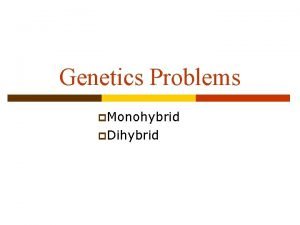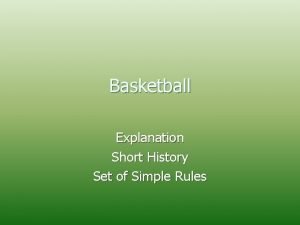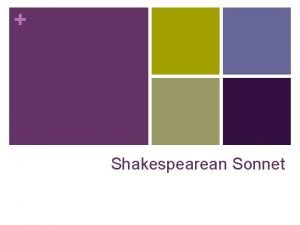The Sonnet A short history of the sonnet










- Slides: 10

The Sonnet

A short history of the sonnet • The term “sonnet” derives from the Italian “sonetto”, a “little sound or song”. • The first examples are those written by Iacopo da Lentini in 1230; • The sonnet establishes its importance as a poetic form with Petrarch’s “Canzoniere” (started in 1335); • Petrarch describes his love for his beloved Laura using the typical features of courtly love. • The poet is a man who suffers because of a disdainful lady who is beautiful, and often cruel; • The Petrarchan lady is a woman who is both real and ideal, full of the highest physical and spiritual qualities; • The poet feels contrasting sensations: happiness or sorrow, love or hatred according to the presence or absence of the lady or to his different states of mind;

Italian sonnet • rigid structural form: the poet is asked to express his thoughts and feelings in fourteen lines Petrarchan sonnet • Fourteen iambic pentameters divided into: • two stanzas, one octave and one sestet, usually rhyming: • ABBA. • CDECDE or CDCDCD (even if the rhyme scheme sometimes varies). • The function of the octave is: • to introduce a problem or a situation • The function of the sestet is: • to provide an answer or comments on the situation and expresses the personal feelings of the poet.

The sonnet in England Sir Thomas Wyatt (1500 – 1542) – first English poet to introduce the Italian sonnet to England. • Initially, he simply translates the poems into English; • then, to adapt the Italian pattern to the English language, he leaves the octave unchanged and modifies the sestet dividing it into a quatrain and a couplet. • Sometimes Wyatt’s quatrain and couplet seem more like a sestet; • The Petrarchan theme of love remains unchanged. • With the Earl of Surrey (c. 1517 -1547) the final couplet becomes separate from the quatrain and comments on the previous twelve lines. • Surrey also changes the octave into two quatrains with different rhymes;

• The final pattern that distinguishes the Elizabethan sonnet from the Petrarchan one consists of three quatrains and a couplet, and its rhyme scheme is: ABAB-CDCD-EFEF-GG. • The couplet is always epigrammatic: it has the function of: Ø summing up the subject matter dealt with in the previous twelve lines or. . . Ø reversing the meaning previously discussed. Fortune • The fortune of the genre is due to the publication of “Astrophel and Stella” (1591) - a sequence of sonnets by Philip Sidney. • A sonnet sequence is a series of sonnets on a particular theme addressed to a particular person.

The sonnet in England Theme • The commonest theme is love and in the case of Sidney, his love with Stella. • In accordance with Petrarch’s model, it is a conflictual love, full of tenderness and bitterness, hatred and possession. Spenser’s “Amoretti” • Another important sequence of sonnets is the one written by Edmund Spenser (1552 -1599) entitled “Amoretti”, where the poet celebrates his lady and, at the same time, deals with theme of immortality gained through poetry by both the poet and his beloved. Shakespeare’s sonnets • Published in 1609 but written in the last decade of the 16 th century, they are the greatest collection of English sonnets. • They are clearly influenced by the Italian and classical tradition but, at the same time, they are also highly original.

Metaphysical poets • • • Their works are characterised by: elaborate style search for the unusual intellectualism most famous representative of metaphysical poets: John Donne Cavalier poets • • Their works are characterised by: classical elegance clarity most famous representative of Cavalier poets: Ben Jonson

Main characteristics of sonnets • A fourteen-line poem in iambic*pentameter. • A carefully patterned rhyme scheme. • Invented by the Italian Iacopo da Lentini in the first half of the 13 th century. • Introduced into England by Sir Thomas Wyatt. • Two types of sonnet: Petrarchan and Shakespearean. *Iamb: Type of foot made up of an unstressed syllable followed by a stressed one

Table of comparison Petrarchan sonnet Shakespearean sonnet 14 lines of iambic pentameter Division into 2 sections: the octave presents a problem or situation the sestet solves or clarifies the situation Division into 4 sections: 3 quatrains present a problem or situation a couplet solves or summarizes the problem. Rhyme scheme: ABAB or ABBA for the octave CDECDE or CDCDEE for the sestet Rhyme scheme: ABAB Quatrain I CDCD Quatrain II EFEF Quatrain III GG Couplet

Chivalric poem • Very popular during the Renaissance period • Developed in France and Italy and then spread all over Europe • The “Faerie Queene” (1591 - 1596) by Edmund Spenser is the best example of this genre in England • In his work, the poet creates an imaginary world in which knights, ladies, fairies, gods and goddesses tell fantastic tales through which he celebrates Queen Elizabeth and her court. • The allegorical form of the poem allows the poet to contrast Protestant England with her Catholic enemies such as the Vatican The Christian epic poem • The most important example of Renaissance epic is John Milton’s “Paradise Lost”. • The temptation of Adam and Eve in the Garden of Eden and man’s loss of paradise are the main themes of this poem. • The influence of Greek and Roman literature as well as of Christian humanism are quite evident in Milton’s masterpiece


















